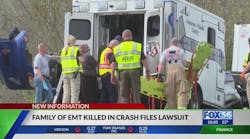For those answers, I turned to my good friend, Mark McLees, who is the captain of the Syracuse, NY Fire Department's Rescue Company 1 (and a fellow Firehouse® contributing editor). The Syracuse Fire Department's pre-emption system has been in use for well over 20 years. I asked Captain McLees for his perception and observations of Syracuse's experience with its pre-emption system. I thank him for his contribution to this column.
In 1959, the department suffered the loss of a fire officer and a firefighter when two responding engine companies collided at an intersection. After that incident, traffic control at intersections was a major concern.
Prior to installing the pre-emption system in the 1970s, the department used a crude but effective traffic control system. Dispatchers could change all the traffic lights downtown to "red" with the flip of a switch. When dispatching a fire alarm to downtown companies, the dispatchers would "turn the diamond red" - referring to all lights in the downtown area. The last responding apparatus would declare on the fire radio, "Clear the diamond." The dispatchers would then return all the traffic signals to automatic operation.
In the 1970s, the Syracuse Fire Department had a nickname, the "Buck Rogers Fire Department." Historians and scholars alike will recall its use of space-age concepts such as automated hydrant gates; remote-control handline valves; 1 3/4-inch handlines with automatic nozzles using rapid water; the mini-maxi concept; a "squad" or manpower company; and traffic light controllers. While many of the aforementioned ideas have since gone by the wayside, there remains in use today one system that has proven itself over and over, and that is the pre-emption system. Since Syracuse installed the pre-emption system, it has not had an intersection accident involving two fire apparatus.
With the pre-emption system, the department instituted a few rules:
- Apparatus are NOT allowed to pass through any red lights. If, while responding to an alarm the traffic signal does not turn green, it usually means that another responding apparatus has "grabbed" the light from a different direction.
- Responding apparatus are allowed to proceed through a red light only after a full stop and insuring that no other responding rigs are following.
- Each Sunday every intersection-sensing device is checked. Fire companies are required to check every traffic signal in their districts from two different directions to see if the emitters and sensors are working properly.
Understanding how the system works is critical for all chauffeurs and officers. If the light is green for you, the system will "hold" it green until you pass. When a sensor detects a responding fire apparatus, it cycles through the "green/yellow/red" pattern rapidly, in an effort to have the light green by the time the emergency vehicle reaches the intersection.
If you respond too fast, you can overrun the system, and the light will not be green. This phenomenon is dependent on how closely the intersections are spaced, and how fast the responding apparatus are traveling.
Some other observations were made by Syracuse fire personnel:
- Firefighters love the system.
- Snow can accumulate in the receivers on the traffic lights and the light reflects back rather than into the sensor.
- The fire department brought pre-emption into the city when a major transformation was taking place. In the 1970s, the fire chief closed about a half dozen stations and consolidated others. The rapid response offered by the pre-emption system gave the chief the ability to close firehouses and maintain a reasonable first-due response time and surprisingly short second-due response times.
I also asked Captain McLees whether drivers tend to drive much faster with the pre-emption system knowing that they probably would not have to stop. He felt that control of the driver is not a function associated with the pre-emption system. It is a function of a good officer. Drivers have tendency to gain "invincibility" knowing they will have the green light 99.99% of the time. The problem, as I stated, was the civilian who sees a traffic light turning yellow and "guns" the engine to beat the red light, figuring the other civilian waiting at the red light will most likely hesitate before enter the intersection. Unfortunately, the responding apparatus that has grabbed the light has momentum and speed - and probably is out of the civilian's field of vision.
Do Syracuse's apparatus drivers rely on the system?
Captain McLees replied, "Absolutely - and most have only known a world that includes the pre-emption system. But I would not trade it for the world. Like anything, there are some flaws, but in this near-perfect world, it comes close to making intersection accidents almost non-existent."
Michael Wilbur, a Firehouse® contributing editor, is an FDNY lieutenant in Ladder Company 27 in the Bronx and a firefighter in the Howells, NY, Fire Department. He is an adjunct instructor at the New York State Academy of Fire Science and the Orange County Fire Training Center. Wilbur has developed and presented emergency vehicle operator courses throughout the country and has consulted on a variety of fire apparatus issues.




